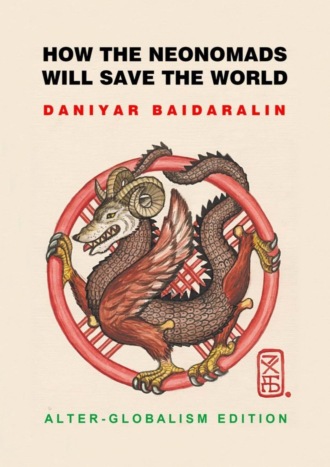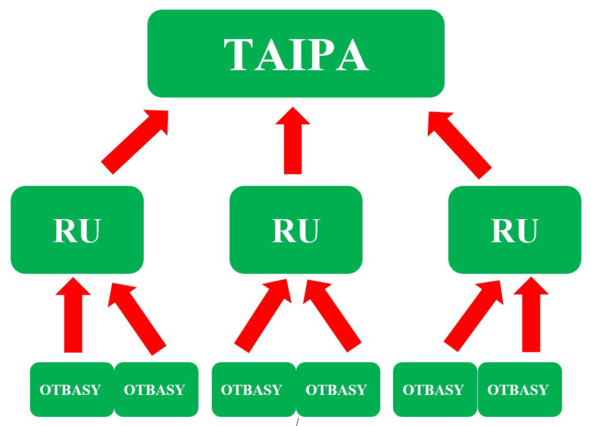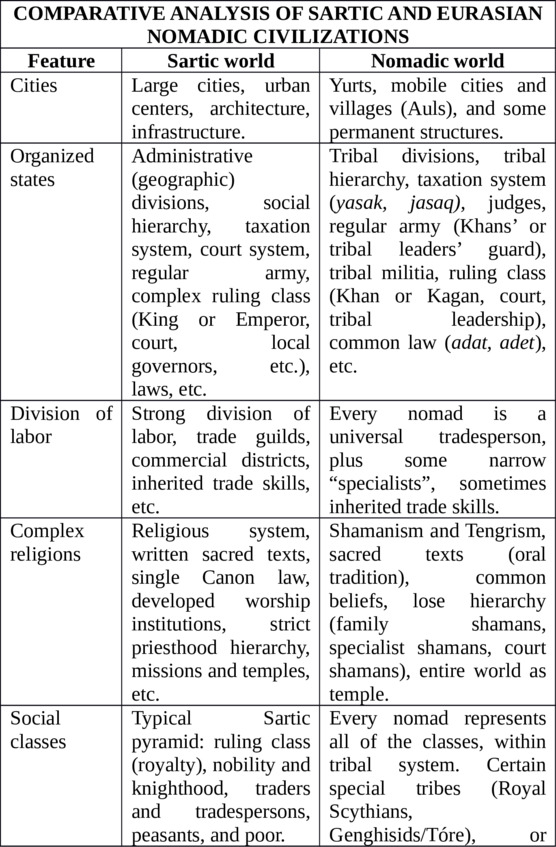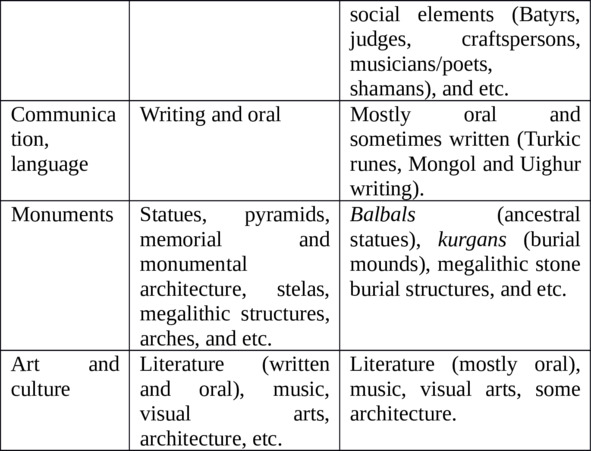
Полная версия
How the Neonomads will save the world. Alter-globalism edition
By the Middle Age the Patriarchal trend has gradually reached the Eurasian Nomads and most rulers were male. However, even then the women remained influential in politics, and basically acted as gray cardinals, directing their royal husbands from behind the scenes. Great nomadic leaders like Genghis-Khan had multiple wives, but their position was different from that of the Islamic or Chinese harems. In the harems, the wives were basically living in one palace, with a strict hierarchy of senior, middle tier, and junior wives, and the eunuch who were serving/supervising them.
In EN society, each of wives had her own nomadic Aul consisting of a few or more yurts, cattle herds, herdsmen and servants, and sometimes even her own guards. Basically, each of wives had her own small nomadic state within a state, where she was a full master. Even in less rich families with two or more wives being a part of one Aul with shared cattle, each of wives had her own yurt where she lived with her children, and other wives had no direct control over her possessions.
But even in the middle ages sometimes noble women forwent the behind-the-scenes routine and ruler openly. This happened more than once in the so-called Mongol Empire. One of the ancestor of Mongols is Alan-Gua, a mythical pra-mother. In Genghis-Khan’s own life there was an array of important women: his mother Hoelun, his first and senior wife Borte, his relative Altani who received the title of Baatar for being a brave warrior, his junior wives, sisters Yesugen and Yesui, among many others. They played significant roles at certain moment during the forging of empire. Finally, the wife of his third son, the Great Khan Ögedei, named Töregene Khatun was a direct ruler of the empire for a few years until her son Güyük Khan became the next Great Khan.
The Patriarchy never reached the same heights in the Great Steppe as it did in Europe, Middle East, Central Asia, or China. Even in the 19 century, after the majority of the Eurasian Nomads were converted to Islam, the status of women remained comparatively high. Even when under the Islamic law, nomadic women never wore full-veil or were as separated from men as they were in the SC Islamic nations. th
The high social status of women in the ENC could be traced from the religious beliefs. In the Bronze Age and Early Iron Age times, the female goddesses were treated as equal to male gods. A good chunk of Scythian/Saka pantheon is made of female deities. Many of them lost their prominence, but one goddess name have survived till today and is still regarded among the Kazakhs: the Goddess . She was one of the highest-ranking ancient goddesses of fertility, matron of all mothers and wives. Some modern-day Kazakhs still conduct millennia-old Umai rituals when the new babies arrive. Umai
Another sign of equality between men and women in the nomadic society is in the very base of all Turkic languages. There are about half a hundred live and extinct Turkic languages, but they all share the same feature: there are no words for «he» or «she» in all of them. Instead, all Turkic languages refer to persons of both genders equally as «ol» or «o». If a Turkic-speaking person wants to specify gender of a person, he or she just have to use words «this/that man» () or «this/that woman» (). This is a major detail that tells us a lot about how the nomads traditionally viewed men and women. mynau/anau erkek mynau/anau qatyn
Traditional nomadic family
The Eurasian Nomads managed to keep and preserve a very old human social construct known as Tribalism which traces back to late Stone Age and Bronze Age. In a simplified form, the EN tribes () consisted of smaller units, such as family clans (), which in turn were formed by families (). A few of would form an extended family that physically manifested itself in a form of a nomadic village called . Taipa Ru Otbasy, Janúya Otbasy Aul
Of course, extended families in EN societies were much larger than those of the SC nations, and could incorporate dozens or even hundreds of people. That is because the meaning of the word «blood relatives» included the genetic kin up to seven generations back, a principle knows as (Seven Male Ancestors). Jety Ata
The nuclear families, consisting of primary parents and their biological children, could also include adopted relatives’ children, older parents, or other relatives. These nuclear families were parts of extended families, which included siblings, cousins, aunts, uncles, once-removed relatives, twice-removed relatives, and fourth-generation relatives, and so on till seventh-generation relatives, both on paternal and maternal sides, as well as the children and relatives of father’s other wives (polygyny).
The marriages within these seven paternal generations were strictly prohibited to avoid interbreeding. Why seven? Since we’ve learned about genes in 20—21 centuries, some calculated that the chances of genetic mutations due to interbreeding decrease every passing generation, as shown in a table below. Back down seven generations, and the risk of it becomes as low as between 0 to 1%. How did my ancestors figured out the exact amount of generations of Y-chromosome needed to weed out the risk of genetic mutations? I don’t know exactly. But this explains why the nomads had superior genes and were famous for their health and endurance. st
Table showing the distribution of Y-chromosome within seven generations
The extended families of seven-generation relatives could be as large as a few dozens, hundreds, or even thousands of members, because of the added polygynic families. A few of such extended families, formed a clan (Ru). A few dozens or hundreds of clans, still considered related, would belong to a single tribe (Taipa), usually all stemming from the same ancestor. Sometimes new Rus could be added either through marriage or war, or for political reasons.
Most of possessions and wealth within EN families were shared, including livestock, yurts, equipment, weapons, and etc. The notion of private property was weak. A friend or relative could ask for pretty much anything, and it was considered impolite to refuse. Even to this day some of the post-EN nations are known for their generosity and selflessness.
At the same time, the families, clans, and tribes were sensitive about matters of honor, therefore, insulting, injuring, or killing a member of another tribe, even not a very important one, would be considered an assault on the entire clan or even a tribe, and the revenge would follow. Sometimes it led to lengthy bloody vendettas that lasted for generations. But this was a good crime preventing policy in a nearly-stateless society, for one had to think twice before doing something bad.
A simplified structure of Eurasian Nomadic Tribalism
The relationships within families, clans, and tribes were warm, trustful, and cooperative. Every member of the tribe could travel within all of its Auls and receive the same treatment in every yurt. If a family had to adopt children of a diseased of killed relative, these children would be equaled to own children and treated with the same level of respect and attention. Growing up, adopted children would consider themselves as part of an adoptee family/clan, and view adoptive parents as their own.
Aul members would gather together and provide collective help if someone needed it; for example, in a process of shearing sheep wool or making felt. In times of sorrow, if someone died, which happened too often, the whole clan would come to help and be around at all times for a few weeks, a tradition still called (expressing sympathy) among the Kazakhs. This was and still is a great family therapy, which much more efficient and affordable that hiring a therapist for money. Kóńil Aitu
Today, in a Post-Industrial world, the tribalism is often viewed negatively as something archaic and outdated. It is considered that it leads to suppression of individual freedoms (arranged marriages), women rights (polygyny), as well as nepotism, clan wars and revenge, and sometimes even bloody vendettas. Indeed, when put in a foreign urban environment, with overcrowded population and nowhere else to go, the nomadic tribalism might manifest itself that way. But when it exists in its natural element, such as pastoral nomadic society living in the open Steppe, it makes most sense.
For example, the seemingly cruel and bloody tradition of revenge in practice is meant to combat crimes when there is no police or centralized governments. The arranged marriages yielded low rate of divorces and spouses living together till death parted them. Polygyny gives some single women a chance to start a family with father, when there are no free men available. The «nepotism» in nomadic pastoral economy means common interests, trust, and quality cooperation. The Jety Ata principle means that the risk of interbreeding and resulting mutations is almost zero. Added to this the emotional stability and comfort from knowing that you are never along when you need help or support, and that the entire clan or tribe is behind you at all times.
All together this system, which evolved naturally over the millennia, produced resilient social fabric, capable to resist the harsh life conditions and endless wars that the Eurasian Nomads were forced to lead.


Nomadic military
The EN developed efficient military machine by constantly fighting each other and the SC nations. So good it was at the peak of the ENC’s evolutional development that a few in numbers nomads routinely defeated the vast SC nations.
A Xiongnu (Hun) nation of just a couple hundred thousand conquered and terrorized a multi-million strong China, and this success was repeated by many succeeding nomadic nations. The 20—40 thousands strong Mongol army conquered almost all of the inhabited Eurasia in 13 century, defeating most of the states that it encountered in China, Central Asia, Russia, Eastern Europe, Middle East, and India. The SC nations with all of their economic might and human resources simply couldn’t stop the nomads, who went through them like a hot knife goes through butter. th
So how did the nomads achieve such impressive victories with such low numbers and scares resources? The standard SC answer would be that they were so evil and barbaric that war was all they knew and could do well. A more educated SC answer would mention tough lifestyle that formed a strong fighting nation, where every men was a soldier and was trained to ride horses and use weapons since early childhood, perfected their martial arts and military cooperation in collective hunts, used a few horses per warrior to march long distances, had an iron discipline and a decimal army structure. Again, that is only a formal listing of the features without understanding the essence.
But what really made the nomads such effective warriors and their armies to be victorious military machines? I think it is hard for a SC representatives to admit that in the pre-Industrial Era the ENC have developed a far superior economic and social system that brought up the best in all of its people, and allowed the most efficient use of human and material resources.
The increased sense of belonging, honor, human spirit, self-respect and responsibility made one average Eurasian Nomad be worth dozens of average SC persons. The nomads were able to overcome incredible difficulties, survive on little available resources, and make insufferable sacrifices in order to achieve their victories. To put it simply, the ENC created conditions in which the majority of its members reached such heights of human condition that only a few best representatives of the CS could match them.
And even in Industrial Era it wasn’t the increased efficiency or improved quality of the SC armies that defeated the ENC initially, but a shear increased volume of cheap soldiers that simply overwhelmed the nomads by vast difference in numbers. It was a case of millions of mosquitos killing a lion.
Of course, later on the SC guns and military technology became so efficient that even a few SC soldiers could withstand attacks by large units of nomads, but that came a few centuries later. And even with these improved weapons the SC had a hard time fighting the nomads in open fields, and preferred using tactics of building forts and fortifications.
THE CONCEPT: NOMADISM VS SARTISM
What is Sartism?
Technically, the term «Sart» was applied to a settled Muslim ethnicity in Central Asia. I write more on this in the Appendixes. But for our purposes I will be using the second meaning of this term referring to representatives of any Settled Civilization. The Eurasian Nomads, particularly Kazakhs, used the term «Sart» to distinguish any «settled peoples living of agriculture and commerce trade».
In today’s Kazakhstan, the terms and are often used as a generic term to describe all of the non-nomadic, settled nations of the world, including the Europeans, Russians, Chinese, Persians, Islamic World, and etc. Basically, all of the neighboring nations of the nomads of the Great Eurasian Steppe, and sometimes even wider, including the Americas and Australia. Sart Sartism unofficially
From here onwards I will be referring to Settled Civilization as «Sartic Civilization» with abbreviation «SC».
The intellectuals in post-nomadic nations, such as Kazakhs, Kyrgyzs, Mongols, Bashkirs, Turkmens, and etc., often love to discuss the «binary duality» of the Nomadic-Sartic relationships, the differences in our psychology and economy, mentality, and etc. The Nomads and Sarts viewed as two sides of coin, two opposite civilizational systems that conflict one another and could never be brought to one.
To be completely honest, the EN used term «Sart» derogatively, because they didn’t respect this way of life. The Kazakhs, Kyrgyzs, Karakalpaks, and other nomads despised the Sartic lifestyle. From the nomadic perspective, living in such way was a disgrace for human spirit: instead of roaming free in the open Steppes entrusting your life to the strength of your horse, your own sword, your wits, and the Gods; the Sartic peoples would voluntarily lock themselves into four walls, subject themselves to strict and unnatural hierarchies, being choked to half-death by forceful taxation, worked hard into early deaths, were brainwashed by their political and religious leaders, cheated at every possible occasion, separated into classes and castes, and etc.
The EN preferred to live free and dangerously, than to have a sense of false security in exchange for human liberties. The nomads were generous and often didn’t know the price of their wealth. The Sarts knew perfectly all market prices for goods and foods, because his livelihood depended on it, but nomads simply knew that they had herds of cattle that they could trade for anything they needed.
For the most part the nomads never knew any money, preferring natural exchange of goods in mutual payments. They simply didn’t see any value in money, often using valuable Sartic coins for decorations or as material for jewelry. Sometimes the nomads would buy expensive textiles and take them apart threat by threat, simply because they loved the colors and they wanted to make ropes of these threats.
The Sarts, of course, paid a similar respect to the nomads, considering them to be rude, uncivilized, and dangerous. The two civilizations couldn’t be more different, but they needed each other for trade and joint military campaigns. Often the SC nations would invite or simply hire the nomads into their military forces to fight against their SC neighbors. This was a good deal, because for a good price the SC nation would receive a fully-equipped and excellently-trained first-class cavalry, instead of trying to build their own. And in other times only the nomads could provide the SC nations with their numerous durable steppe horses, vast herds of sheep, and strong steppe camels.
Of course, too often the nomads raided their Sartic neighbors, and every so often the EN even conquered them and include them into their colossal, vast empires that sometimes stretched from Korea to Europe. Usually when it happened the SC nations didn’t have strong and swift enough army to protect their lands, and would routinely fall before the Steppe conquerors. The nomads would often sack the entire cities and whole countries, but usually they would simply crash the SC ruling and military class, and install their own.
Of course, such conquests hid the invisible danger for all of the Steppe conquerors. The danger was, to put it simply, of «going soft» after living long time in the Sartic nations, eating their tender foods, enjoying their softer climate and cozy lifestyles, getting used to their diverse leisure and pleasures, bedding their women and fathering children with them who will get spoiled. In a few generations, the thick nomadic blood got so watered down with the thinner SC blood that there was nothing left of a once powerful dynasty. Then the next wave of fresh Steppe nomads would come and deposit the rotten nest and take their place, just to get corrupted and erode in the same way.
The EN realized the dangers of this process. Many conquerors preferred to keep their nomadic lifestyle, continuing to roam around in their mobile yurt cities around the captured cities. Sometimes the entire nomadic states or even empires got split because the most traditional part of the nomads didn’t want to be in the same nation with the Sarts. For instance, this is how the two modern Central Asian nations got formed: the Kazakhs and the Uzbeks. They used to be in one semi-nomadic state, called the State of the Nomadic Uzbeks. But then they split into two separate states: the one that preferred to mix with the Sarts and settle became the modern day Uzbeks, and the one that preferred to stay nomadic became the today’s Kazakhs.
The Sarts of Eurasia always viewed the EN as an uncontrollable, wild, alien, strange, deadly, and often even as a punishing force of nature. On the opposite side, the nomads considered their Great Steppe to be locked into a ring of Sartic nations (Sartic Civilization Ring, SC Ring) that threatened to choke them and take away their precious free lifestyle.
Sometimes the Sartic world produced own conquerors, and they invaded the Great Steppe, subjugating the nomads into their SC empires. The Persian Achaemenids and Alexander the Great both invaded the nomadic realm and caused major disruption, some Chinese dynasties made successful advancements deep into nomadic territories; the non-nomadic Central Asian empires often stroke at nomads, and turned them into their vassals.
Therefore, both the Nomadic and Sartic civilizations had love and hate relationships for thousands of years, while also mutually enriching and feeding each other via the inevitable cultural and technological exchange.
Sartism vs Nomadism
As I described in previous chapter, the nomadic society was complex, vibrant, and well-established. It had a conceptual framework, integral system, social fabric, economic basis, political construct, culture, communication, and conscious self-awareness. It represented the alternative model of civilization.
Unfortunately, the Eurasian Nomads were universally considered «barbarian», wild beasty peoples without rule of law and human rights. The SC collective genetic memory holds an image of endless hordes of stocky horse riders with Mongoloid faces, wearing animal furs, shooting rains of arrows, wielding curved sabers, screaming madly and destroying anything they see.
It is hard to blame the SC nations, because for millennia this is exactly what they saw every time they encountered the EN. They never knew about the delicate, intricate inner life of the nomadic society, because it was hidden from the SC eyes in the vast plains of Eurasia. And by the time the Sartic explorers have finally had a chance to visit the Great Steppe in Modern Age and see the nomadic life, it was already too late: the wrong image was already cast in concrete, and the nomadic society was collapsing, allowing only a glimpse at its prior greatness.
Even in the Sartic academic circles of Modern Era there is still an incorrect point of view of the Eurasian Nomads. There is no official recognition of the Eurasian Nomadic Civilization. The EN still remain proverbial «bad guys of history» who never got a chance to be called «a civilization».
This negative perception happened only because the EN didn’t meet some of the definitions of «civilized» in the Europe-centric, China-centric, or Islam-centric SC (I will call it ). But in reality the EN had all the features of a full-bodied civilization, simply in a different configuration, as shown in a table below. Sartic-Centrism
As we can see from the table, the EN world had the same features as the Sartic civilizations of the past. The main difference is that the Sartic Civilization always preferred to rely on complex systems and institutions at the expense of individual freedoms, while the ENC relied more on personalities and individuals, their reason and common sense, and had simplified systems and institutions.
The main qualities of a Sartic person, to this day, are his successes, wealth, social status, possessions, estates, and etc. For an EN person the main qualities were his or her honor, honesty, skills, personal aptitudes, and . The last one is kind of hard to imagine in a tough Steppe warrior, but in reality this is probably the main quality in a nomadic person from the nomadic perspective. The Kazakh word of humanness is and it is still valued most of all. humanness adamgershilik,
For three millennia this form of civilization gave the Eurasian Nomads advantage over their overwhelming SC Rim neighbors, allowing them not only withstand the enormous pressure, but even actively invade and dictate their will to their civilizational adversaries.


Nomads as the sanitarians of the Nature
If you would’ve asked a regular representative of any SC nation today what they think of the Eurasian Nomads, sadly the majority most likely wouldn’t say anything at all, as they’ve never even heard of it. Those few who know the word, would probably remember «bloody» Attila the Hun and murderous Genghis-Khan and the large hordes of cruel, brutal, genocidal invaders. Basically, the nomads are seen by most as unhuman, destructive force of nature, similar to hurricanes or other natural disasters.
Конец ознакомительного фрагмента.
Текст предоставлен ООО «Литрес».
Прочитайте эту книгу целиком, купив полную легальную версию на Литрес.
Безопасно оплатить книгу можно банковской картой Visa, MasterCard, Maestro, со счета мобильного телефона, с платежного терминала, в салоне МТС или Связной, через PayPal, WebMoney, Яндекс.Деньги, QIWI Кошелек, бонусными картами или другим удобным Вам способом.
Примечания
1
SOBR – Spetsyalny otryad bystrogo reagirovanya (special unit of fast response)

